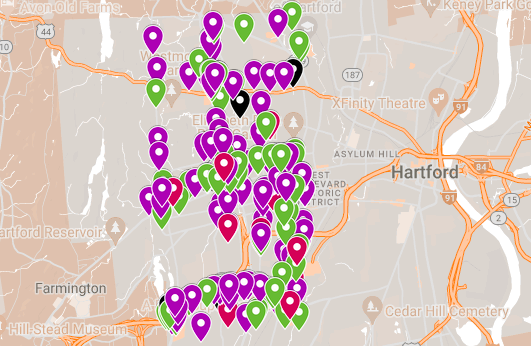
 If you’ve spent any time in Hartford’s parks, you have encountered the vans being driven or parked on the grass, sidewalks, and pathways. An able-bodied person can generally just walk onto the grass when the van blocks the path, though anyone else might have to wait, take a detour, or try navigating snow or a mushy ground with a cane, stroller, or wheelchair.
If you’ve spent any time in Hartford’s parks, you have encountered the vans being driven or parked on the grass, sidewalks, and pathways. An able-bodied person can generally just walk onto the grass when the van blocks the path, though anyone else might have to wait, take a detour, or try navigating snow or a mushy ground with a cane, stroller, or wheelchair.
There are times when DPW needs to transport larger items, but is this happening all of the time that vans are idling on walkways? Do motorized vehicles need to be the default transportation, or could they be used on an only-when-necessary basis?
The new administration will have the opportunity to rethink how operations are carried out at many levels. This may include re-establishing a Parks and Rec department, but since I don’t have a crystal ball either, can not begin to speculate where these changes may begin and end. Instead, I can provide some suggestions.
The High Line is a well-funded public park that was built on and continues to integrate elements of an old freight line in Manhattan. Its design is long (1.45 mi.), narrow, elevated, and contains several turns. While it is wheelchair accessible, motorized vehicles and bicycles are not allowed — with the exception of the small fleet of Worksman tricycles used for maintenance.
 These industrial trikes are stored on site when not in use. There are no emissions. They can be maneuvered to park in more versatile ways than a van. Bicycles cost far less to maintain and repair; there are no fuel tanks to refill.
These industrial trikes are stored on site when not in use. There are no emissions. They can be maneuvered to park in more versatile ways than a van. Bicycles cost far less to maintain and repair; there are no fuel tanks to refill.
This also expands the pool of potential employees because a driver’s license is not needed. We talk a lot about removing barriers to employment in Hartford; here’s a way to do more than talk.
Besides the exercise that City employees would be getting, there would literally be more transparency, as the public would be able to see more of what workers were up to. With the troubles plaguing DPW in recent years, it might not hurt to try other ways of increasing visibility and accountability.
But more than keeping costs lower and everyone on task, it’s common sense that moving at a slower pace, not surrounded by a metal cage, helps people to see what is on all sides of them. A stroll or bike ride through the park will mean seeing graffiti sooner, noticing which lights have burned out, recognizing trip hazards, and more.
Good bike locks would be needed, along with the directive to use them. There would be resistance from those who have become car-dependent and don’t believe changing habits is possible. But we are days away from having an almost clean slate on City Council and the Mayor’s Office. It would benefit us all to rethink the culture of City departments: increase sustainability, reduce costs, and improve efficiency and transparency. The next time a van needs to be retired, replace it with a couple work bikes (or trikes).

Jody Wynn Rodiger
Awesome !!! Thank you for this good work !!!
Christopher Brown
I think it would also be great if the Hartford Parking Authority used bicycles. The cars they use for parking enforcement take up space unnecessarily when parked and increase congestion when they are being driven on Hartford’s streets (usually for very short distances).
Tom Baptist
Thanks for your thoughtful suggestion. Always looking for new ways to improve City parks and this will be considered along with other ideas to increase sustainability and efficiency. ~Tom Baptist, DPW Superintendent
Kerri Provost
Thanks for the feedback!